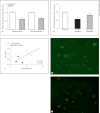Alveolar macrophage cathelicidin deficiency in severe sarcoidosis
- PMID: 22759465
- PMCID: PMC3472801
- DOI: 10.1159/000339149
Alveolar macrophage cathelicidin deficiency in severe sarcoidosis
Abstract
Background: Dysfunctional immune responses characterize sarcoidosis, but the status of cathelicidin, a potent immunoregulatory and antimicrobial molecule, has not been established in clinical disease activity.
Methods: Alveolar macrophage cathelicidin expression was determined in biopsy-proven sarcoidosis patients classified clinically as 'severe' (requiring systemic treatment) or 'non-severe' (never requiring treatment). Bronchoalveolar lavage (BAL) cells from sarcoidosis patients and healthy controls were analyzed for mRNA expression of cathelicidin, vitamin D receptor (VDR) and the VDR coactivator steroid receptor coactivator-3 (SRC3) by quantitative PCR. Cathelicidin-derived peptide LL-37 was determined by immunocytochemistry. Serum calcidiol (25-hydroxyvitamin D2; vitD2) and calcitriol (1,25-dihydroxyvitamin D3; vitD3) were quantified.
Results: The results indicated reduced BAL cell expression of cathelicidin and SRC3 in severe but not non-severe sarcoidosis compared to controls. Serum levels of biologically active vitD3 in both severe and non-severe patients were within the control range even though vitD2 levels in both groups were below the recommended level (30 ng/ml). Sarcoidosis and control alveolar macrophages were studied in vitro to determine cathelicidin responses to vitD3 and tumor necrosis factor-α (TNFα), a vitD3 antagonist elevated in active sarcoidosis. Alveolar macrophage cathelicidin was stimulated by vitD3 but repressed by TNFα, which also repressed SRC3.
Conclusions: These findings suggest that TNFα-mediated repression of SRC3 contributes to alveolar macrophage cathelicidin deficiency in severe sarcoidosis despite healthy vitD3 levels. Deficiency of cathelicidin, a multifunctional regulator of immune cells and proinflammatory cytokines, may impede resolution of inflammation in the lungs of patients with severe sarcoidosis.
Copyright © 2012 S. Karger AG, Basel.
Figures




Similar articles
-
Cathelicidin as a link between sarcoidosis and tuberculosis.Sarcoidosis Vasc Diffuse Lung Dis. 2015 Sep 14;32(3):222-7. Sarcoidosis Vasc Diffuse Lung Dis. 2015. PMID: 26422567
-
Depressed peroxisome proliferator-activated receptor gamma (PPargamma) is indicative of severe pulmonary sarcoidosis: possible involvement of interferon gamma (IFN-gamma).Sarcoidosis Vasc Diffuse Lung Dis. 2006 Jun;23(2):93-100. Sarcoidosis Vasc Diffuse Lung Dis. 2006. PMID: 17937104
-
Cathelicidin augments VDR-dependent anti-leishmanial immune response in Indian Post-Kala-Azar Dermal Leishmaniasis.Int Immunopharmacol. 2017 Sep;50:130-138. doi: 10.1016/j.intimp.2017.06.010. Epub 2017 Jul 12. Int Immunopharmacol. 2017. PMID: 28662432
-
[Bronchoalveolar lavage in sarcoidosis].Nihon Rinsho. 2002 Sep;60(9):1766-71. Nihon Rinsho. 2002. PMID: 12233073 Review. Japanese.
-
Sarcoidosis and the alpha chemokine MIG.Clin Ter. 2020 Mar-Apr;171(2):e161-e166. doi: 10.7417/CT.2020.2207. Clin Ter. 2020. PMID: 32141489 Review.
Cited by
-
TREM-2 Receptor Expression Increases with 25(OH)D Vitamin Serum Levels in Patients with Pulmonary Sarcoidosis.Mediators Inflamm. 2015;2015:181986. doi: 10.1155/2015/181986. Epub 2015 Jun 16. Mediators Inflamm. 2015. PMID: 26166951 Free PMC article.
-
Sarcoidosis and calcium homeostasis disturbances-Do we know where we stand?Chron Respir Dis. 2019 Jan-Dec;16:1479973119878713. doi: 10.1177/1479973119878713. Chron Respir Dis. 2019. PMID: 31718265 Free PMC article. Review.
-
Macrophages: past, present and future.J Innate Immun. 2013;5(6):657-8. doi: 10.1159/000356293. Epub 2013 Oct 26. J Innate Immun. 2013. PMID: 24192658 Free PMC article. No abstract available.
-
A transcriptomics-based meta-analysis identifies a cross-tissue signature for sarcoidosis.Front Med (Lausanne). 2022 Sep 20;9:960266. doi: 10.3389/fmed.2022.960266. eCollection 2022. Front Med (Lausanne). 2022. PMID: 36203777 Free PMC article.
-
Inflammation and vitamin D: the infection connection.Inflamm Res. 2014 Oct;63(10):803-19. doi: 10.1007/s00011-014-0755-z. Epub 2014 Jul 22. Inflamm Res. 2014. PMID: 25048990 Free PMC article. Review.
References
-
- Chen ES, Moller DR. Sarcoidosis - scientific progress and clinical challenges. Nat Rev Rheumatol. 2011;7:457–467. - PubMed
-
- Iannuzzi MC, Rybicki BA, Teirstein AS. Sarcoidosis. N Engl J Med. 2007;357:2153–2165. - PubMed
-
- Opitz B, van Laak V, Eitel J, Suttorp N. Innate immune recognition in infectious and noninfectious diseases of the lung. Am J Respir Crit Care Med. 2010;181:1294–1309. - PubMed
-
- Nijnik A, Hancock RE. The roles of cathelicidin LL-37 in immune defences and novel clinical applications. Curr Opin Hematol. 2009;16:41–47. - PubMed
-
- Sorensen OE, Follin P, Johnsen AH, Calafat J, Tjabringa GS, Hiemstra PS, Borregaard N. Human cathelicidin, hCAP-18, is processed to the antimicrobial peptide LL-37 by extracellular cleavage with proteinase 3. Blood. 2001;97:3951–3959. - PubMed
Publication types
MeSH terms
Substances
Grants and funding
LinkOut - more resources
Full Text Sources
Medical
Miscellaneous

